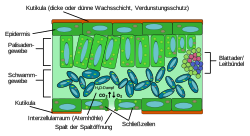Intercellular
Intercellulars ( Latin inter "between" and cella , cellula "cellar, small space, cell") are gas-filled cavities between neighboring cells in plant tissues . These intercellular spaces arise during tissue development after cell division and usually form a coherent system in differentiated tissues.
education
Intercellulars arise in one of three ways:
- In schizogenic formation (from Gr. Schizein “to split”), neighboring cells move apart during growth due to the rounding of the cells and the dissolution of the central lamellae between the cell walls .
- During the lysigenic formation (v. Gr. Lýsis , "solution, dissolution, termination"), intercellular areas arise through the dissolution of cells.
- During the rhexigenic formation (v. Gr. Rhexis , "tear") the tissue tears due to uneven growth.
function
The intercellular system is connected to the outside air via stomata and lenticels and thus enables an optimal gas supply to the cells. Depending on the number and size of the intercellular tissue, a distinction can be made between "dense" and "loose" tissues. The former include e.g. B. the closure and strengthening tissue, the second the photosynthetically active chlorinechymes (assimilation tissue ), which require a lively gas exchange.
In the case of aerenchyma ("ventilation tissue"), intercellulars make up up to 70% of the tissue volume. Aerenchymes are often found in marsh and water plants and serve to supply submerged organs with air. Other plants also form aerenchymes when they are flooded, the formation of which is triggered by the phytohormone ethylene . In many plants, however, this subsequent re-function of tissue leads to a partial loss of function and possibly to death.
The so-called spongy parenchyma of the foliage leaf due to its numerous intercellular structures serves as both aerenchyma and chlorenchyma.
In addition to the function of ventilation, intercellular structures also change the optical properties of tissues. Due to the refraction of light at the transition from fluid to air-filled spaces, intercellular tissues appear opaque. In the absence of other dyes, the fabric then appears white, e.g. B. many petals .
swell
- Peter Sitte , Elmar Weiler , Joachim W. Kadereit , G. Neuhaus, Uwe Sonnewald : Textbook of botany for universities. 36th edition. Founded by E. Strasburger. Spectrum Akademischer Verlag, Heidelberg 2008, ISBN 978-3-8274-1455-7 .
- Christian Brunold , Adrian Rüesegger , Roland Brändle (eds.): Stress in plants. UTB, Stuttgart 1996, ISBN 3-8252-8125-6 .

